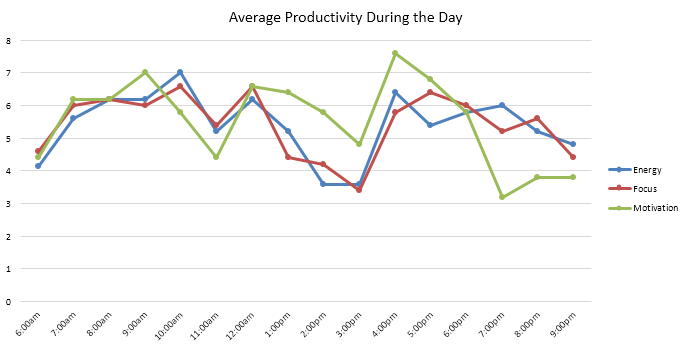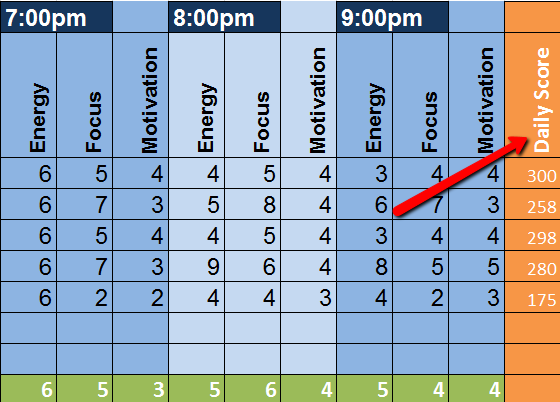
Not all hours are created equal. Sometimes an hour is enough to blaze through a massive project, and other times all you manage is to tiredly send a couple of unimportant emails.
Motivational speakers, performance coaches, and CEOs advocate finding and leveraging your peak hours of the day as the key to being more productive. Following a schedule that utilizes your most productive work hours will ensure that the important projects receive the energy investments they deserve.
Here’s an official plan to help you harness those productivity power hours:
Follow The (Ultradian) Rhythm
Like anything in nature, humans run in cycles. The growing body of research on ultradian rhythms – 90-120 minute cycles that run within the 24-hour circadian day – suggests that our day is driven by cycles that affect how alert and productive we are.
At the beginning of the cycle, we experience heightened energy and focus, and at the end, we may feel scatterbrained and fatigued. Is your computer crashing from the million tabs you have open? Likely, you are right in that energy valley.

Image Source: MentalHealth.com
Earning the title of “workaholic” might sound impressive, but in fact, productivity drops once you have clocked in over 50 hours in one week. So in terms of output, working your best hours may very well trump working longer hours. Awesome news, right?
Use your peak time, when you feel alert and excited, for projects that involve problem-solving, complex thought, and critical decisions.
If you work on these activities when you’re in the energy trough, you will have to fight your groggy brain, and the project will take much longer (not to mention it will be more painful!).
Routine, unimportant, and less complex tasks can be done when you are not as focused and engaged. Even if you feel sleepy, you can still make it through the weekly catch-up meeting (just prop those eyelids open).
If you know exactly when to expect your next energy surge, you are more certain that you can and will achieve your goals for the day.
Self-employed professionals, who by some estimates will exceed 40% of the workforce by 2020, can choose which hours they work. Likewise, many companies now offer flexible hours and work-from-home options to their employees. This means millions of working professionals now have the opportunity to work at the times they feel alert, inspired, and productive.
But all of this begs the question: How do you know when your most productive hours are?
Take A Systematic Approach
While you could go with your gut feeling and your lark/night owl tendencies to identify your peak hours, taking a systematic approach is best. A Life Of Productivity author Chris Bailey took a year off to engage in several productivity experiments, including tracking his productive hours. He suggests recording focus, energy, and motivation scores for 3 weeks, taking measurements at the same times every day so the data isn’t skewed.
The following spreadsheet, based on Chris’ workflow, will help you track your productivity: (download it here)
![]()
Average productivity by the hour is reflected in a graph:

Tracking these three metrics should only take you about 30 seconds every hour. Don’t obsess over the numbers you assign to each metric. Usually the first number that pops into your head is the correct one. The spreadsheet will automatically calculate the averages and build out your personal productivity graph.
You will see trends even after one week of tracking, but the more data you gather, the more reliable your trends will be. An extra perk of tracking for a longer time is that in addition to your most productive hours, you will also determine the days of the week when you are able to move mountains.
This spreadsheet calculates the Daily Score as the sum of all the metrics for that day.

After two or three weeks you might see trends showing your most productive days.

Trent Hamm, in his article for The Simple Dollar, recommends creating a framework schedule based on your most productive days. It enables you to knock out the mundane tasks on days when your brain is a bit dimmer and save the creative power for the projects that will actually make a difference.
Journal For Better Insights
Often you will find your focus, energy, and motivation to be highly correlated, and that makes sense. Occasionally, however, you will find out these metrics don’t go hand in hand. For example, your energy is at a 10, but you have trouble focusing. In this case, note the reason for this variance – have you had one too many cups of coffee? (Hey, we’ve all been there.)
The Notes column of this spreadsheet is created to capture those insights daily and serve as a mini-work journal. Here you can write what has been accomplished, what motivated you, and what was a roadblock. If a task seems particularly challenging at a certain time of the day, make a note of it – and then schedule it in a different time slot.

Besides the daily notes, you can also add cell comments when using this spreadsheet. These are convenient to mark the hours when you drank coffee, had lunch, exercised, or did something else that could affect your energy flow. Chatting with your loved one or playing with a pet counts, too.

While the graphs show you the WHEN of your productivity cycle, the notes and the cell comments may give you clues to the WHY.
Leverage What You Find
Use your peak time carefully. You want to be solving problems, getting answers, and making decisions in your most productive time. Writing, deep thought processes, and strategizing all come easier when you are focused and alert. These activities are a longer sprint, so you need to bust out some Usain Bolt level concentration to win.
As much as your work environment allows, protect your peak time from intrusions and commitments that don’t require your full brain power.
Dig into the questions, “What makes me more productive? What activities, foods, or even people drain my energy?” Then apply that knowledge, even if it means saying goodbye to double cheese pepperoni pizza for lunch.
And Finally: Learn To Work The Right Hours
Keep in mind that some of the productivity valleys are just our body’s natural way of saying, “Hey, I need a break.” You shouldn’t expect to eliminate all of your energy dips. However, being aware of them and working during your power hours already makes a day more enjoyable and productive.
Here’s to logging in the right hours, not the longer ones.







































